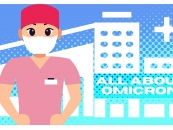
Rural India has less than one Doctor for 1000 People
by Yash Saboo January 2 2018, 5:12 pm Estimated Reading Time: 2 mins, 44 secsIn a country like India where the population is on its boom, there is still less than one doctor for 1000 people, a study by healthcare information provider IMS Health has revealed. The problem is all over the country, especially in rural areas. This compares poorly with the benchmark put up by the World Health Organisation, which recommends at least four doctors for every 1,000 people.
As per information provided by the Medical Council of India, there were a total 10,22,859 allopathic doctors registered with the state medical councils or Medical Council of India as on March 31 last year. “Assuming 80 percent availability, it is estimated that around 8.18 lakh doctors may actually be available for active service. It gives a doctor-population ratio of 0.62:1000 as per current population which is estimated to be of around 1.33 billion,” said Minister of State for Health Anupriya Patel during Question Hour.

your local doctor
The IMS Health Physician and Chemist Census, conducted across 120 Indian cities covering over 3.73 lakh doctors and 99,000 chemists, has revealed that the ratio of doctors to people in India stands at an alarming 0.65, compared to the global average of 1.2, and two for an emerging country like Thailand. Mumbai, which has a population of 1.8 crores, has 31,000 doctors, while Delhi, with a population of 1.6 crores, has 40,500 doctors.
The WHO prescribes a doctor-population ratio of 1:1000. The doctor-population ratio of the some of the countries are: Australia – 3.374:1000, Brazil – 1.852:1000, China -1.49:1000, France – 3.227:1000, Germany – 4.125:1000, Russia -3.306:1000, the USA – 2.554:1000, Afghanistan – 0.304:1000, Bangladesh – 0.389:1000, Pakistan – 0.806:1000.
It is also important to recognize that doctors trained under modern infrastructure are unwilling to work in rural areas under the prevailing conditions. Majority of the students who have access and wherewithal to study medical education are predominantly from the urban middle class, whose expectations are drawn from their urban socialization and aspiration.
Rural areas do not have the social infrastructure such as roads, schools, electricity, internet connectivity and so on to match with the expectations and aspirations of the urban youth. The young doctors in rural areas also find it difficult to manage and get access to professional support such as laboratory, conferencing and senior medical advice, etc. that are key to their career progress.
Thus, their career prospects and the quality of life they can expect to provide to their future families and children in an isolated environment is much below their social aspirations and dreams. Part of the resistance to rural service also comes from the fact that a large proportion of doctors train themselves as specialists. Specialist doctors are most likely to set up their service bases in urban areas in order to quickly recover their training costs or repay loans obtained for their education.
“Emphasis of the government was to increase the number of doctors in the country to improve the doctor population ratio. There are 479 medical colleges in the country with an intake capacity of 67,218 MBBS seats. 12,870 MBBS seats have been added in the last three
years”, said Ms. Patel. A new cadre of healthcare workers are necessary to help improve access of healthcare services in rural area and this initiative needs to be implemented on a pan-India basis to make significant positive impact on rural health care and achieve health targets of the SDGs by 2030.




-173X130.jpg)
-173X130.jpg)
-173X130.jpg)
-173X130.jpg)
-173X130.jpg)
-173X130.jpg)

-173X130.jpg)